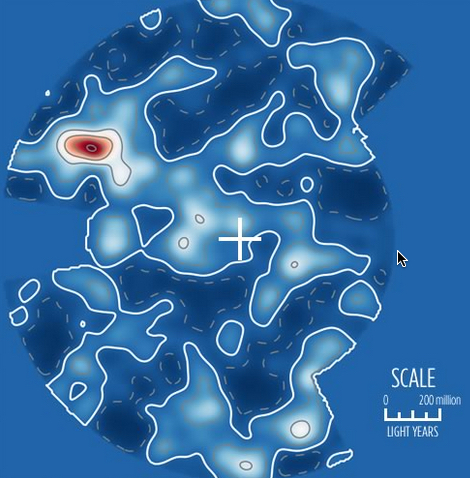The most comprehensive 3-D map of the universe
April 29, 2015

A slice through the 3D map of the nearby universe. Our Milky Way galaxy is in the center, marked by a cross. The map spans nearly two billion light years from side to side. Regions with many galaxies are shown in white or red, whereas regions with fewer galaxies are dark blue. (credit: University of Waterloo)
Astrophysicists have created a 3D map of the universe that spans nearly two billion light years and is the most complete picture of our cosmic neighborhood to date.
The spherical map of galaxy superclusters will lead to a greater understanding of how matter is distributed in the universe and provide key insights into dark matter, one of physics’ greatest mysteries, the astronomers say.
“The galaxy distribution isn’t uniform and has no definable pattern. It has peaks and valleys much like a mountain range. This is what we expect if the large-scale structure originates from quantum fluctuations in the early universe,” said Professor Mike Hudson of the Department of Physics and Astronomy at the University of Waterloo, who co-created the map. The map appears online in an article in the peer-review journal, Monthly Notices of the Royal Astronomical Society.
The lighter blue and white areas on the map represent greater concentrations of galaxies. The red area is the supercluster called the Shapley Concentration, the largest collection of galaxies in the nearby universe. Unexplored areas appear in medium blue.
Understanding dark matter
Knowing the location and motion of matter in the universe will help astrophysicists predict the universe’s expansion and identify where and how much dark matter exists.
Scientists have observed that galaxies move differently because the universe’s expansion is not even. These differences are called peculiar velocities. Our own Milky Way galaxy and its neighbor Andromeda are moving with a speed of 2 million kilometers per hour.
Previous models haven’t fully accounted for this observed motion. Hudson and his team are interested in discovering what structures are responsible for the peculiar velocities. These deviations in the motion of galaxies are a valuable tool to determine the distribution of matter and dark matter on the largest scales.
Dark matter accounts for a large majority of the mass content in the universe. It is a hypothesized form of matter particle that does not reflect or emit light and as a result it can’t be seen or measured directly. The existence and properties of dark matter can only be inferred indirectly through its gravitational effects on visible matter and light.
“A better understanding of dark matter is central to understanding the formation of galaxies and the structures they live in, such as galaxy clusters, superclusters and voids,” said Hudson.
The next step will involve getting more detailed samples of peculiar velocities to enhance the map, in collaboration with researchers in Australia.
Abstract of Cosmological parameters from the comparison of peculiar velocities with predictions from the 2M++ density field
Peculiar velocity measurements are the only tool available in the low-redshift Universe for mapping the large-scale distribution of matter and can thus be used to constrain cosmology. Using redshifts from the 2M++ redshift compilation, we reconstruct the density of galaxies within 200 h−1 Mpc, allowing for the first time good sampling of important superclusters such as the Shapley Concentration. We compare the predicted peculiar velocities from 2M++ to Tully–Fisher and SNe peculiar velocities. We find a value of β* ≡Ω0.55m/b∗= 0.431 ± 0.021, suggesting Ω0.55mσ8,lin = 0.401 ± 0.024, in good agreement with other probes. The predicted peculiar velocity of the Local Group arising from the 2M++ volume alone is 540 ± 40 km s−1, towards l = 268° ± 4°, b = 38° ± 6°, only 10° out of alignment with the cosmic microwave background dipole. To account for velocity contributions arising from sources outside the 2M++ volume, we fit simultaneously for β* and an external bulk flow in our analysis. We find that an external bulk flow is preferred at the 5.1σ level, and the best fit has a velocity of 159 ± 23 km s− 1 towardsl = 304° ± 11°, b = 6° ± 13°. Finally, the predicted bulk flow of a 50 h−1 Mpc Gaussian-weighted volume centred on the Local Group is 230 ± 30 km s−1, in the direction l = 293° ± 8°, b = 14° ± 10°, in agreement with predictions from Λ cold dark matter.